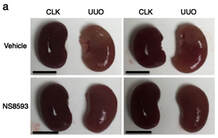The Suzuki Laboratory was established in January 2021 at The Queen’s Medical Center. The lab is headed by Sayuri Suzuki, Ph.D. and located within the University of Hawaii Tower on the campus of The Queen’s Medical Center.

Dr. Suzuki’s primary research interest is in nephropathy involving kidney fibrosis. The goal is to identify underlying cellular mechanisms involved in kidney fibrosis, discover a novel drug that helps protect from damage inflicted by inflammatory processes, and identify new diagnostic biomarkers for kidney disease. One of the mechanisms focuses on ion channel physiology, in particular on the TRP channel family, which reaches beyond kidney disease and into cancer biology. In collaboration with Dr. Daniel Romo, Baylor University, she is developing a pharmacophore targeting TRPM7 channels in hypoxic disease. In collaboration with Dr. Williams, she is probing natural products isolated from cyanobacteria as active drugs against TRPM channels.

Principal Investigator
Tel: 1 (808) 691-7930
Fax: 1 (808) 691-7939
sasuzuki@queens.org

Professor of Chemistry
University of Hawaii at Manoa
O’Donnell T.J., Luo Y., Yoshida W.Y., Suzuki S., Sun R., Williams P.G.
Journal of Natural Products (2022).
DOI: doi.org/10.1016/j.ceca.2021.102521 PMID: https://pubmed.ncbi.nlm.nih.gov/35142496
Suzuki, S., Penner, R., & Fleig, A.
Scientific Reports 10, 2333 (2020).
DOI: https://doi.org/10.1038/s41598-020-59355-y PMID: https://www.ncbi.nlm.nih.gov/pubmed/32047249
Suzuki, S., Lis, A., Schmitz, C., Penner, R., & Fleig, A.
Cellular and Molecular Life Sciences: CMLS 75(16), 3069–3078 (2018).
DOI: https://doi.org/10.1007/s00018-018-2786-z. PMCID: https://www.ncbi.nlm.nih.gov/pmc/articles/PMC6033657
Starkus, J. G., Poerzgen, P., Layugan, K., Kawabata, K. G., Goto, J.-I., Suzuki, S., Myers, G., Kelly, M., Penner, R., Fleig, A., & Horgen, F. D.
Journal of Natural Products 80(10), 2741–2750 (2017).
DOI: https://doi.org/10.1021/acs.jnatprod.7b00515. PMID: https://www.ncbi.nlm.nih.gov/pubmed/29019677
Jansen, C., Sahni, J., Suzuki, S., Horgen, F. D., Penner, R., & Fleig, A.
Scientific Reports 6, 33459 (2016).
DOI: https://doi.org/10.1038/srep33459. PMCID: https://www.ncbi.nlm.nih.gov/pmc/articles/PMC5024298
Zierler, S., Sumoza-Toledo, A., Suzuki, S., Dúill, F. Ó., Ryazanova, L. V., Penner, R., Ryazanov, A. G., & Fleig, A.
The Journal of Physiology 594(11), 2957–2970 (2016).
DOI: https://doi.org/10.1113/JP271564. PMCID: https://www.ncbi.nlm.nih.gov/pmc/articles/PMC4887679
Ryazanova, L. V., Hu, Z., Suzuki, S., Chubanov, V., Fleig, A., & Ryazanov, A. G.
Scientific Reports 4, 7599 (2014).
DOI: https://doi.org/10.1038/srep07599. PMCID: https://www.ncbi.nlm.nih.gov/pmc/articles/PMC4274504
1356 Lusitana St. UH Tower 8, Honolulu, HI 96813